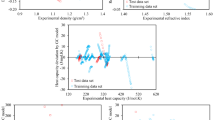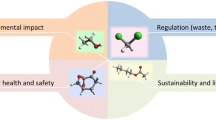Abstract
A solvent has many different types of impact on the environment. This article describes a method that combines several different types of impacts together into one environmental index so that similar solvents may be compared by their cumulative impact to the environment. The software tool PARIS III (Program for Assisting the Replacement of Industrial Solvents III) initially finds thousands of solvents mixtures with behaviors as close as possible to those of the original solvent entered. The overall environmental impacts of these solvent mixtures are estimated and assigned to environmental indexes. Users of the software tool can then choose replacements for the original solvent with similar activities but with significantly smaller environmental indexes. These solvent mixtures may act as practical substitutes for the industrial solvents but substantially reduce the overall environmental impact of the original harmful solvents. Potential replacements like this are found for three of the U.S. Environmental Protection Agency’s Toxic Release Inventory solvents, carbon tetrachloride, toluene, and N-methylpyrrolidone.


Similar content being viewed by others
References
Clark, J.H., Hunt, A., Topi, C., Paggiola, G., Sherwood, J.: Introduction to Solvents and Sustainable Chemistry. Sustainable Solvents: Perspectives from Research, Business and International Policy. (2017), Chap. 1
United States Environmental Protection Agency. Program for Assisting the Replacement of Industrial Solvents (PARIS III). [Online] [Accessed: March 23, 2022.] https://www.epa.gov/chemical-research/program-assisting-replacement-industrial-solvents-paris-iii
Fiksel, J., Eason, T. and Frederickson, H.: A Framework for Sustainability Indicators at EPA. [Online] (2012). https://www.epa.gov/sites/default/files/2014-10/documents/framework-for-sustainability-indicators-at-epa.pdf. EPA/600/R/12/687. Accessed 24 Mar 2022
Eason, T.: Database of Sustainability Indicators and Indices (DOSII) [Online] (2014). https://www.epa.gov/sites/production/files/2016-10/dosii.xlsx. Accessed 6 Apr 2022
Vermeulen, I., Block, C., Caneghem, J.V., Dewulf, W., Sikdar, S., Vandecasteele, C.: Sustainability assessment of industrial waste treatment processes: the case of automotive shredder residue. Resources Conserv. Recycling 69, 17–28 (2012)
Tabone, M., Cregg, J., Beckman, E., Landis, A.: Sustainability metrics: life cycle assessment and green design in polymers. Environ. Sci. Technol. 44(21), 8264–8269 (2010)
Ingwersen, W., Cabezas, H., Weisbrod, A., Eason, T., Demeke, B., Ma, X., Hawkins, T., Lee, S., Bare, J., Ceja, M.: Integrated metrics for improving the life cycle approach to assessing product system sustainability. Sustainability 6(3), 1386–1413 (2014)
Sikdar, S.K.: On aggregating multiple indicators into a single metric for sustainability. Clean Technol. Envi. 11(2), 157–161 (2009)
Sikdar, S.K., Dengupta, S., Harten, P.F.: More on aggregating multiple indicators into a single index for sustainability analyses. Clean Technol. Envi. 14(5), 765–773 (2012)
Guinée, J.B., Heijungs, R., Huppes, G., Zamagni, A., Masoni, P., Buonamici, R., Ekvall, T., Rydberg, T.: Life cycle assessment: past, present, and future. ACS Environ. Sci. Technol. 45(1), 90–96 (2011)
Smith, R.L., Ruiz-Mercado, G.J., Meyer, D.E., Gonzalez, M.A., Abraham, J.P., Barrett, W.M., Randall, P.M.: Coupling computer-aided process simulation and estimations of emissions and land use for rapid life cycle inventory modeling. ACS Sustain. Chem. Eng. 5(5), 3786–3794 (2017)
Lewis, R.J.: Sax’s Dangerous Properties of Industrial Materials. Van Nostrand Reinhold, New York (1996)
PubChem. Hazardous Substance Data Bank (HSDB). [Online] National Library of Medicine. https://pubchem.ncbi.nlm.nih.gov/source/11933. Accessed 24 Mar 2022
The National Institute for Occupational Safety and Health (NIOSH). NIOSH Pocket Guide to Chemical Hazards. [Online]. https://www.cdc.gov/niosh/npg/default.html. Accessed 24 Mar 2022
Martin, T., Young, D., Cabezas, H.: Waste reduction algorithm: chemical process simulation for waste reduction. [Online] United States Envirnomental Protection Agency. https://www.epa.gov/chemical-research/waste-reduction-algorithm-chemical-process-simulation-waste-reduction. Accessed 24 Mar 2022
Harten, P.F., Martin, T.M., Gonzalez, M.A., Young, D.: The software tool to find greener solvent replacements, PARIS III. Environ. Prog. Sustain. Energy 39(1), 1–7 (2020)
Harten, P.F.: Program for assisting the replacement of industrial solvents PARIS III User's Guide. [Online] (2014). https://nepis.epa.gov/Adobe/PDF/P100HVTD.pdf. Accessed 23 Mar 2022
Abrams, D.S., Prausnitz, J.M.: Statistical thermodynamics of liquid mixtures: a new expression for the excess Gibbs energy of partly or completely miscible systems. AICHE J. 21(1), 116–128 (1975)
Acknowledgements
Research performed in the PARIS III Project is supported by the Center for Computational Toxicology and Exposure within the Office of Research and Development of the U.S. Environmental Protection Agency. The authors have no financial or proprietary interests in any material discussed in this article.
Author information
Authors and Affiliations
Corresponding author
Additional information
Publisher's Note
Springer Nature remains neutral with regard to jurisdictional claims in published maps and institutional affiliations.
Rights and permissions
About this article
Cite this article
Harten, P., Martin, T., Chang, D. et al. Finding Potential Replacements for TRI Solvents Using the Environmental Impact of the Average Solvent. J Solution Chem 51, 838–849 (2022). https://doi.org/10.1007/s10953-022-01174-y
Received:
Accepted:
Published:
Issue Date:
DOI: https://doi.org/10.1007/s10953-022-01174-y




